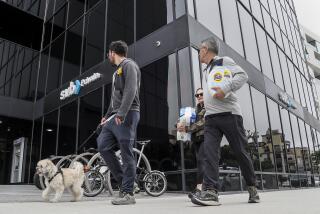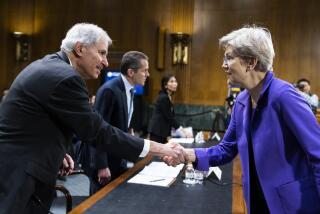Wall Street doubts Fed’s $600-billion lending plan can succeed

- Share via
The Federal Reserve is about to launch a $600-billion gambit to save swaths of U.S. businesses and tens of millions of jobs threatened by the coronavirus crisis. Wall Street is far from confident the Fed can pull it off.
At issue is the Main Street Lending Program, a high-stakes juggling act whose success likely hinges on multiple factors: companies lining up for loans that come with punitive strings attached; banks lending to risky businesses at rock-bottom interest rates — meaning lenders’ profits might be minimal or even nonexistent; getting firms that lack access to debt and equity markets back on their feet amid the worst economic downturn in a generation.
It’s no surprise that Chairman Jerome Powell says Main Street is the most challenging rescue initiative the Fed has tried to set up in response to the pandemic. The program, which Powell said May 29 was just “days” away, targets midsize companies that have largely been left out of the government’s other stimulus efforts, and getting it off the ground has taken more than two months.
The slow rollout, combined with its complexity, has the financial industry questioning whether Main Street will work, especially compared with rapid-response actions that are already up and running, such as the Fed’s plans to buy corporate bonds and exchange traded funds that can invest in high-yield debt.
“I think saying this is likely to be the least successful is probably right,” Matthew Mish, a strategist at UBS Group AG, said of the Main Street program. “There are a number of hurdles where participation is going to be limited.”
Failure could have consequences for the U.S. economy and for President Donald Trump, whose reelection prospects are increasingly tied to businesses weathering the COVID-19 shutdown. Powell has labeled the small- and-medium-size companies eligible for Main Street loans the U.S.’ “jobs machine,” because they employ some 68 million Americans. Widespread bankruptcies among these firms would be a clear setback for the pandemic recovery.
Fed officials declined to comment.
So far, companies have been silent about whether they plan to tap the Fed facility, which is largely seen as a last resort for businesses that can’t get funding elsewhere. Firms that could be good candidates for the loans include smaller retail and restaurant chains, and even sports teams, according to financial analysts.
An upside to the Main Street facility: Certain companies probably won’t face the same backlash for using it as they did for receiving Paycheck Protection Program loans, which are seen as a form of “free money” because the debt can be forgiven if most of it is spent on payroll. The Los Angeles Lakers basketball team returned a $4.6-million PPP loan and Shake Shack Inc. gave back $10 million after they were blasted on social media.
Under the Fed program, businesses with as many as 15,000 employees or up to $5 billion in annual revenue can apply for loans. Most of the financing will come from a vehicle set up by the Fed, though banks will be required to keep at least 5% of any loan on their books. The Fed plans to publish the names of borrowers and the loan amounts they receive on its website.
The Fed can buy up to $600 billion in loans that are issued, and the Treasury Department has provided a $75-billion backstop that can be increased to cover any losses. The Fed says it will purchase loans until Sept. 30, though that date can be extended because Congress has authorized the central bank to keep buying the debt until the end of the year.
“This will be an important effort in supporting the economy, but given the complexities of what the Fed and the government is trying to do with this program, it’s going to be a challenge to make it work,” said Nathan Sheets, the chief economist at PGIM Fixed Income who was a Treasury official during the Obama administration. “Its success will be defined by the unemployment rate coming down.”
Here’s an overview of headwinds the Fed faces.
Strings attached
The Fed imposed some of the same restrictions on its loans as what Congress included in the CARES Act. The $2-trillion stimulus bill prohibited stock buybacks and dividend payments to shareholders until a year after any loans are repaid. The legislation also placed restrictions on executive pay.
Too much, not enough
At the minimum level, the Fed will lend borrowers $500,000 over four years, as it’s seeking to aid companies that are larger than the small businesses targeted by PPP. At the maximum level, most Fed loans can’t exceed $25 million, though companies can add as much as $200 million through the Main Street facility to financing arrangements they currently have with private lenders.
Karen Kerrigan, president and chief executive of the Small Business & Entrepreneurship Council, said the thresholds threaten to “weed out” companies that desperately need just $50,000 or $100,000 to bridge the gap during the pandemic.
Senate lawmakers have a similar gripe. Both Republican John Kennedy of Louisiana and Democrat Sherrod Brown of Ohio have secured promises from Fed officials that they would consider lowering the loan limit. “There is a bias toward the big guys,” Brown said in an interview.
For bigger companies, the upper limits in the Main Street program pose the opposite problem of not being enough money, said Oleg Melentyev, Bank of America Corp.’s head of U.S. high-yield strategy. “It is going to be a very small share of your cash burn taking place right now,” he said.
What’s in it for banks?
Banks that provide funding as part of the program will have to pay the Fed a transaction fee of as much as 1% of the loan amount, a charge they can pass on to borrowers. They may impose an additional 1% fee on companies for originating the loan and will receive an annual servicing fee from the Fed equal to 0.25% of the amount bought by the central bank’s vehicle.
The interest banks earn on the debt, however, is set by the Fed at 3 percentage points over the London Interbank Offered Rate. That level is well below what lenders are charging borrowers rated below investment-grade on the open market. And because of the strings attached to the loans, there’s a good chance the companies will be risky borrowers with limited options to obtain financing.
So banks could arguably be lending at far below market rates to companies that stand a decent chance of defaulting. That’s meaningful considering that lenders will be forced to retain 5% or 15% of the loans on their own books.
No Boeing effect
Fed officials and Treasury Secretary Steven Mnuchin have repeatedly said over the past two months that the mere announcements of government programs that backstop credit markets have boosted confidence on Wall Street, enabling companies to tap private investors for cash injections.
A case in point is Boeing Co. The beleaguered plane maker was in talks with Treasury for a large share of a $17-billion bailout package but ultimately didn’t need government support once credit markets rallied. Instead, it sold $25 billion of bonds.
Even riskier companies that were more directly affected by the shutdowns, such as Gap Inc. and Six Flags Entertainment Corp., have been able to borrow money in the bond market.
But many of the companies eligible for Main Street loans probably won’t benefit from the same phenomenon because they don’t regularly issue bonds or tap the syndicated loan market.
Shadow banks not allowed
Many medium-size companies rely on financing from shadow lenders, an industry that has mushroomed in the years since the 2008 financial crisis as banks retrenched from certain markets in part due to tougher regulations. Non-banks have so far been excluded from government lending facilities, though Powell has indicated the Fed is open to amending Main Street to let them participate.
Keeping non-banks out could delay critical funding for midsize firms, which made up a third of private-sector gross domestic product at the end of 2019, Small Business Investor Alliance President Brett Palmer told Bloomberg in an interview last month.
This report was written with assistance from Kelsey Butler and Catarina Saraiva.
More to Read
Inside the business of entertainment
The Wide Shot brings you news, analysis and insights on everything from streaming wars to production — and what it all means for the future.
You may occasionally receive promotional content from the Los Angeles Times.










